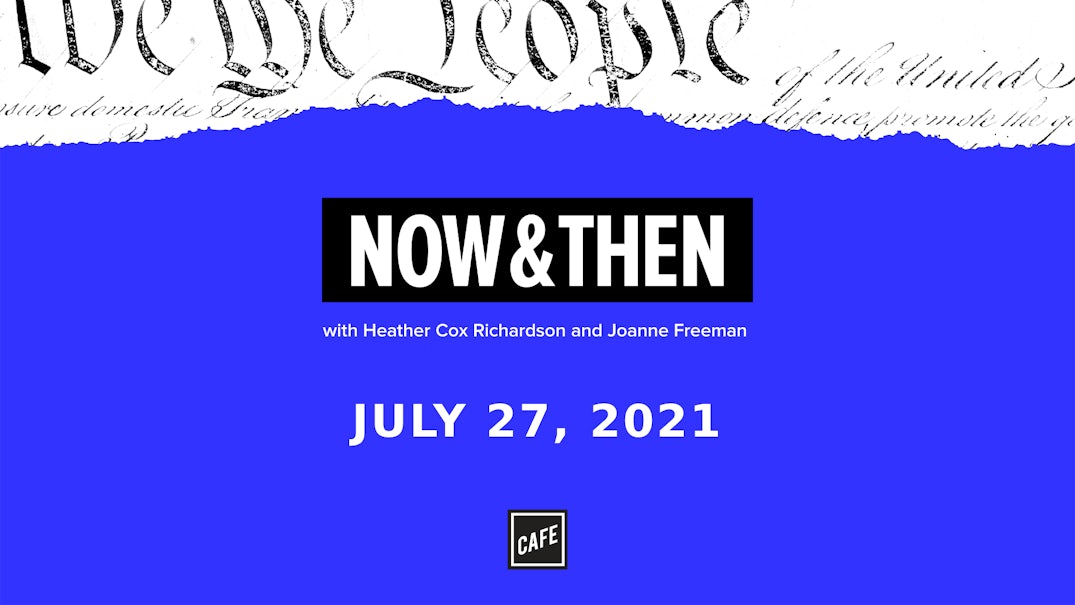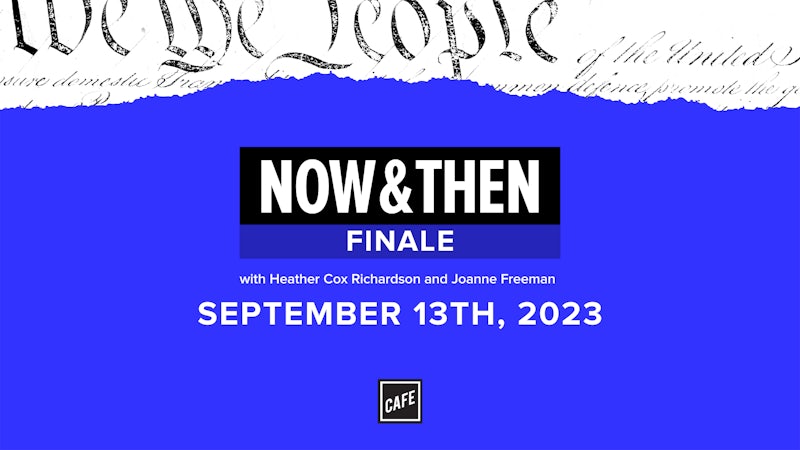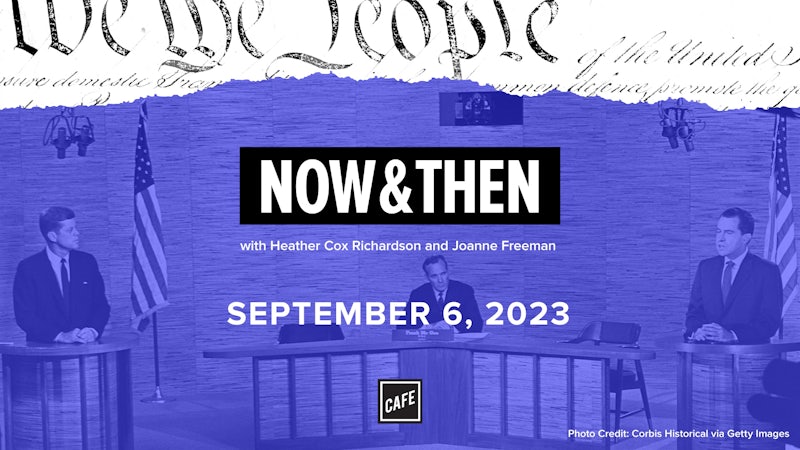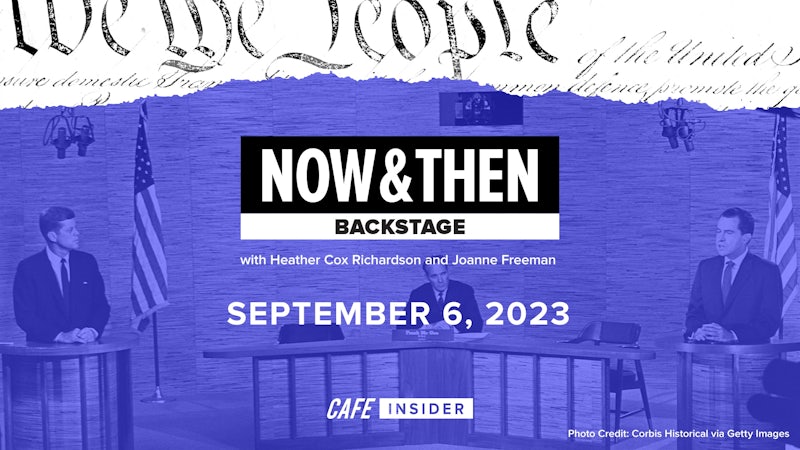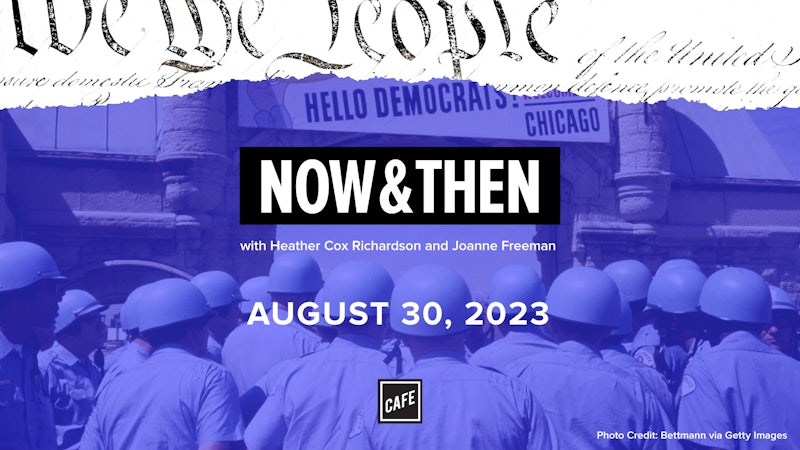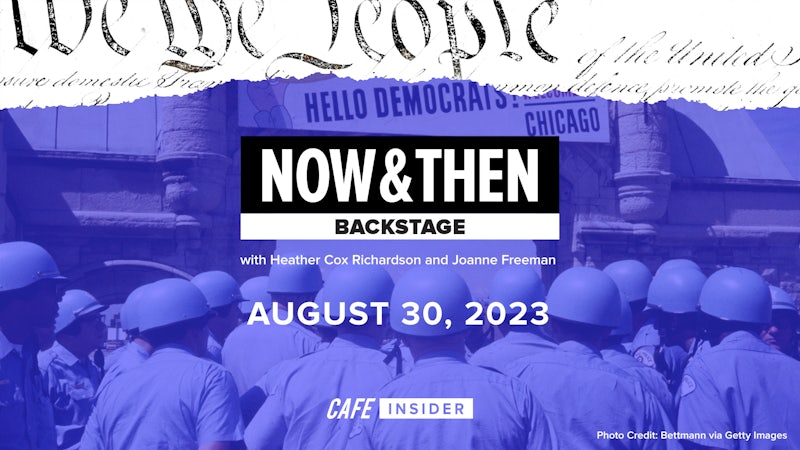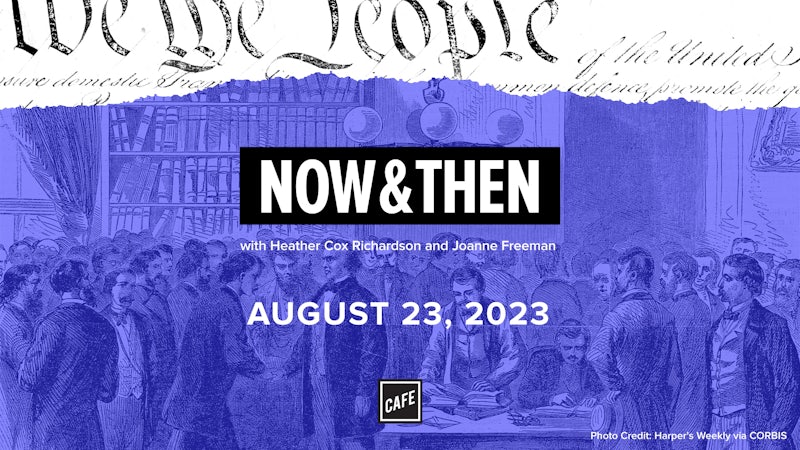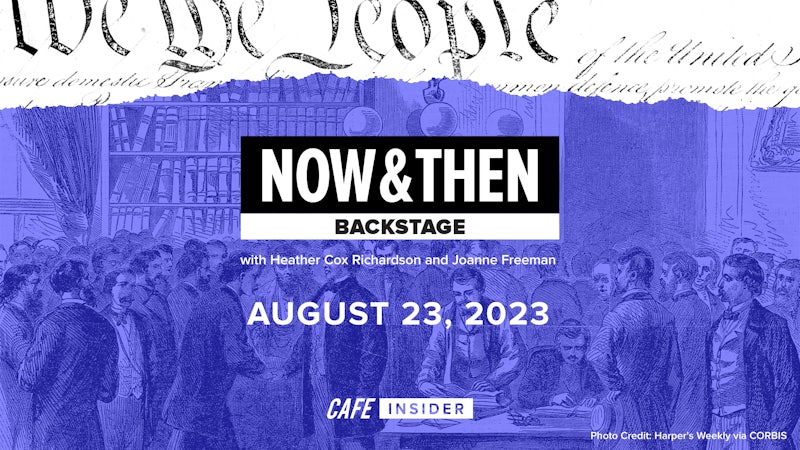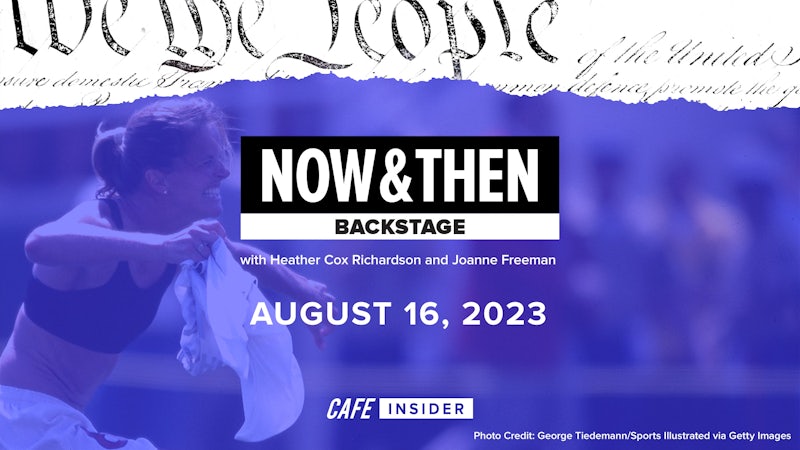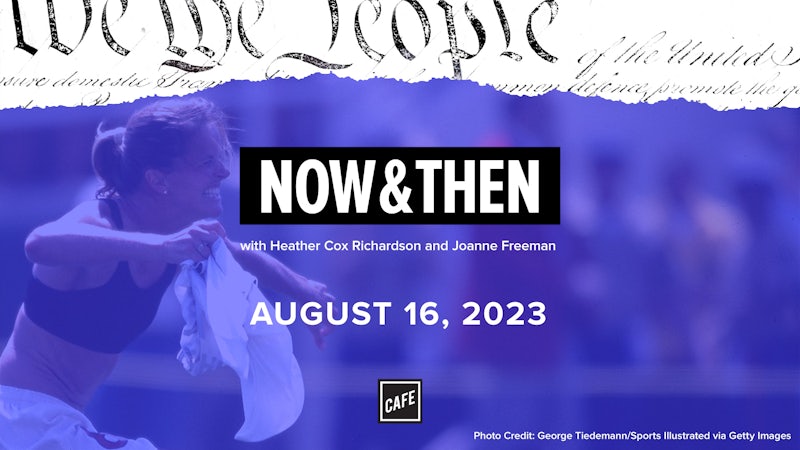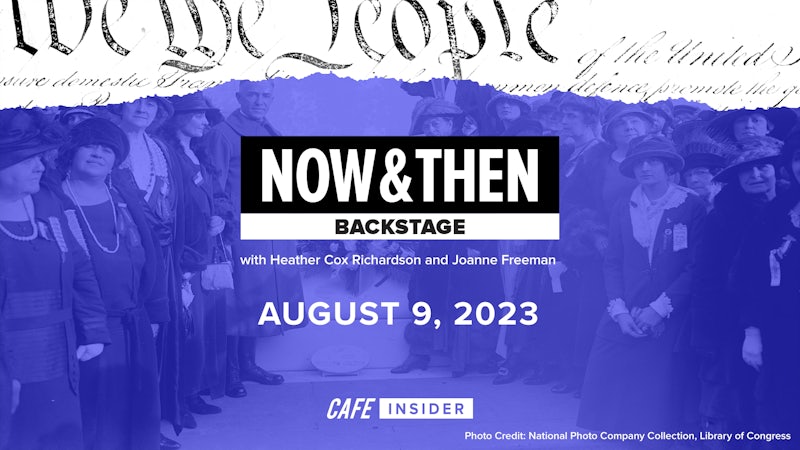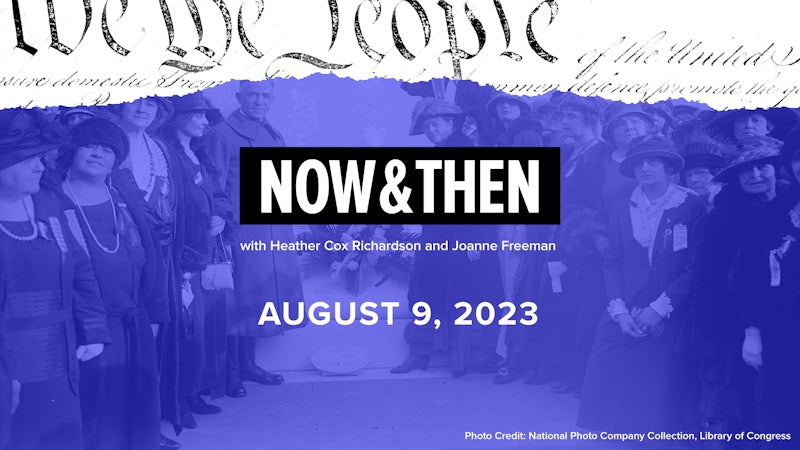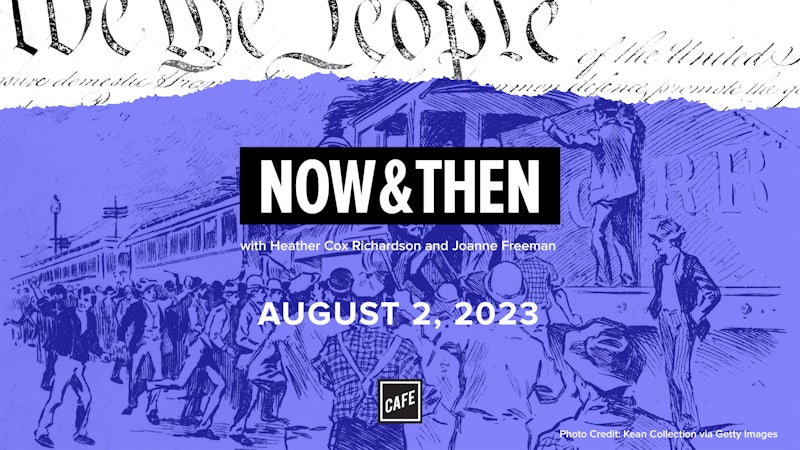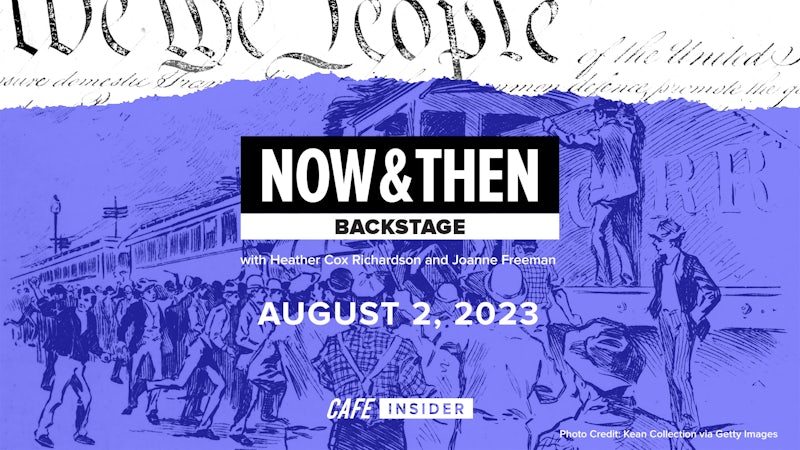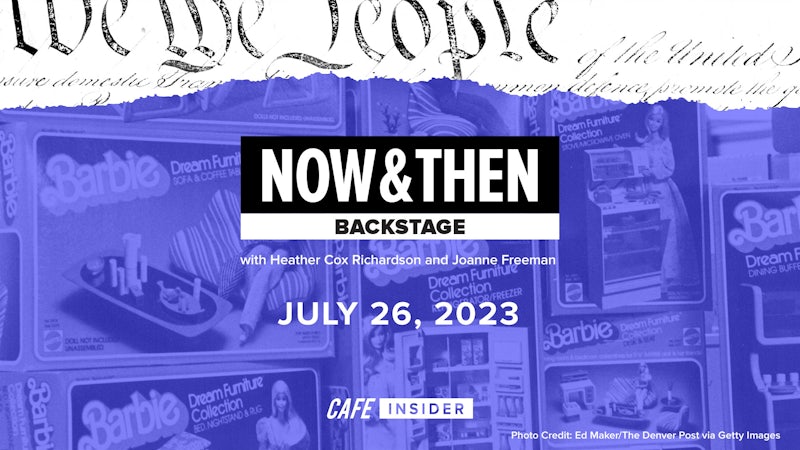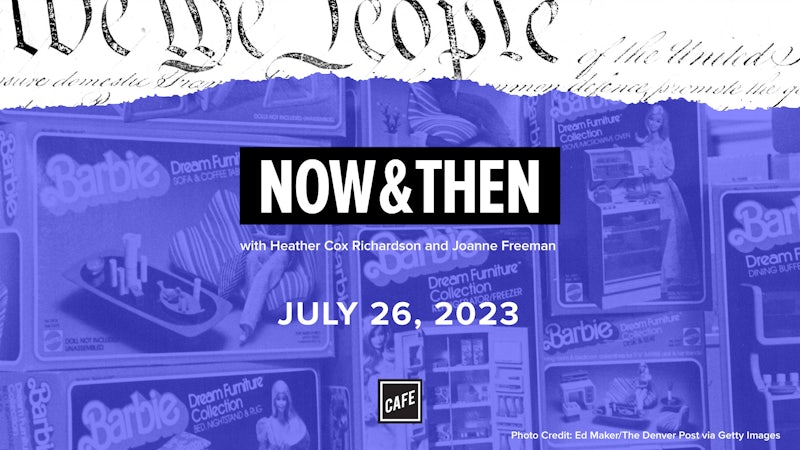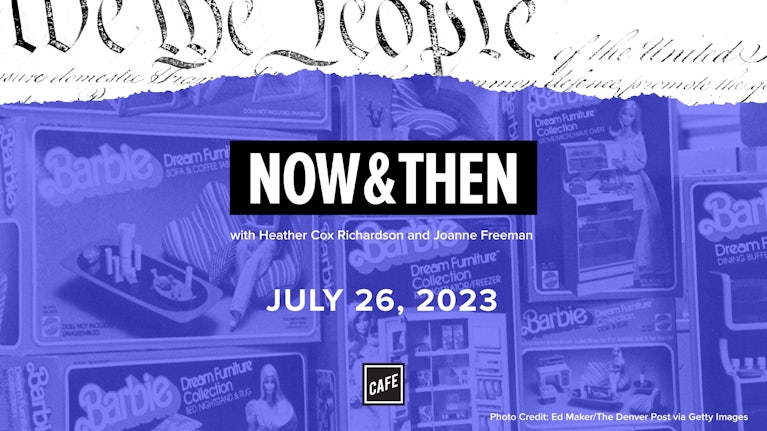Heather Cox Richardson:
From Cafe and the Vox Media Podcast Network, this is Now & Then. I’m Heather Cox Richardson.
Joanne Freeman:
And I am Joanne Freeman.
Heather Cox Richardson:
Today’s episode is all about infrastructure. But before we get started, I should mention that this is actually Infrastructure Week at Café. Preet is interviewing Transportation Secretary, Pete Buttigieg on StayTuned, and they’ll talk about many of the themes that we’ll be discussing today. That episode will come out on the morning of Thursday, July 29th. But today, Joanne and I are going to talk about infrastructure in American history and why it matters.
Joanne Freeman:
And we’ve certainly been, in a sense, talking and not talking about infrastructure for a while now, because it’s been Infrastructure Week now, and again, for years now. To the point that it really is a joke. And so I’m very excited Heather, that you and I are actually taking part in a real Infrastructure Week. And we’re going to actually talk about infrastructure.
Heather Cox Richardson:
Well, I have to say on this whole Infrastructure Week joke, which happened during the previous administration, because whenever they announced it was going to be Infrastructure Week, there was some kind of a disaster. I actually love infrastructure. So I was actually like, wait, wait, I really want an Infrastructure Week. And so now we actually get to talk about why that’s important, which I think is totally cool.
And one of the reasons that we’re picking to talk about it this week, of course, is because currently in front of Congress, there are two infrastructure packages. And while there is a political struggle going on over them that we may or may not get to talk about, what is really interesting for historians is the fact that those two infrastructure packages represent very different ways of looking at what infrastructure actually is.
On the one hand is the bipartisan measure that’s about $579 billion right now, that focuses exclusively on hard infrastructure like roads and bridges and broadband. And that bill has the potential to pick up at least 10 Republican votes. But in contrast to that bill is the other one that the Democrats like, which is way bigger. That bill is about $3.5 trillion, and it has what people are calling human infrastructure measures embedded in it. Things like childcare and extended education.
So on the one hand, you have this old concept of hard infrastructure, and on the other hand, you have a different concept of infrastructure as being inclusive and including humans, as well as asphalt. This is often being called soft infrastructure. And it’s important to note that many of the proposals in this larger soft infrastructure bill, specifically benefit people of color and other groups of marginalized Americans. The expansion of Medicare benefits, green card extensions for some undocumented immigrants, lower prescription drug prices, on and on and on.
Joanne Freeman:
And that’s something that I think probably many people have not thought about before. Certainly I didn’t before I began thinking about this episode, and that is a really basic question, which is, what do we mean when we talk about infrastructure? Because I do think there’s sort of a general assumption that infrastructure is something you talk about from on high, in some kind of sweeping objective way about bridges and roads.
You have to say it in that voice when you say it. And that’s what infrastructure is. And part of what we’re going to be talking today, using history as ever to get at some of the realities here is, traditionally speaking, what has infrastructure been? How have people understood it? And how has it played out?
Heather Cox Richardson:
And I would add, why does it matter? Because at the end of the day, it really is central to what it means to be an American and what the government should do, and the relationship the government should have to its citizens. But I want to start here, because when we started to talk about this, as you usually do, you’re like, well, of course, because I’m like, well, infrastructure Hamilton. We just have to talk about Hamilton and Joanne goes, well, of course that’s not when people start talking about infrastructure, and I had never learned what she’s about to tell you.
Joanne Freeman:
So here’s the thing about so many things in American history, and this is certainly one of them. And that is, the roots go back even before the constitution. And that’s the case of infrastructure. Logical, if you think about it, because once the revolution is over, the war is won, we segue into the 1780s and there are two big things up for debate. And one of them is, how are things going to work as far as the government is concerned? Another one is, what is going to be the connection between the states? And that has to do with politics, and that has to do with geography. How will the states be connected to each other?
Heather Cox Richardson:
And you’re talking about the time of the articles of Confederation between the revolution and what is going to become the constitution, right?
Joanne Freeman:
Correct. And they’re a deliberately not very centralized form of government, they’re kind of weak. So they’re really giving a lot of power to the states, which obviously is something that the constitutional convention will change. But in the 1780s, people are still trying to figure out really what the country is and how it will work. And so they’re pondering how do the states connect to each other, which obviously is leading into what we now would call infrastructure.
And one of the big things that they’re constantly worried about, because it links the states in interesting ways, is waterways. How are the states going to be navigating waterways? How will trade work between states? Ho will taxes work? How will commerce work? How will we basically just do some of the basic things that a nation ought to be able to do within itself? But at this point they haven’t been worked out.
Heather Cox Richardson:
Well, it’s worth mentioning right now that waterways are highways until the 20th century. So basically everything is taking, not everything, I can just hear listeners going, wait, wait, wait. There was a road from… But most things are happening on the water. And that water has real problems with it.
Joanne Freeman:
Correct. And water equals connections between people, water equals business and commerce, water equals everything. There’s a reason why we segue in really the early 19th century into the great canal age, because the canals then really do become the equivalent of super highways as ways of really connecting the nation in a concrete and ambitious kind of way.
But in this early period, we have, for example, Virginia and Maryland, trying to figure out how to navigate the Potomac and deal with… Ruby has very strong feelings about this.
Heather Cox Richardson:
About navigating the Potomac.
Joanne Freeman:
Clearly. And little did I know, he has such strong feelings about that. So Virginia and Maryland are worried about trade between those two states and they decide basically that they will send commissioners to a meeting and try and deal with navigation of the Potomac. Also the Chesapeake Bay, see what they can do to regulate that so that the two states will have economically and geographically, a coordinated way of engaging in trade.
So what starts out as Virginia and Maryland trying to figure this out, George Washington, who has a deep interest in this issue, partly because he’s being broadminded and he’s looking west and he’s thinking, well, whatever we’re doing here on the East Coast ultimately, it’s going to tie into the west and that’s going to be important.
And also because he has a personal interest, because he’s trying to figure out how to create some kind of a company that’s going to take advantage of these new waterways and this new trade. Washington says, why don’t we have this meeting at Mount Vernon? And so the meeting, this initial meeting between Virginia and Maryland takes place at Mount Vernon, Washington’s home. And together, this is-
Heather Cox Richardson:
This is a thing, right? It’s called Mount Vernon Conference or something.
Joanne Freeman:
Yes, it’s called the Mount Vernon Conference.
Heather Cox Richardson:
Well, you have to understand, I truly had never heard of that. So I was fascinated. It’s rare to hit something in American history that I’m like, the what? The who? He did what?
Joanne Freeman:
I did not think of it that way, but indeed. So in 1785, in March of 1785, this is the Mount Vernon Conference. It takes place, logically enough, Mount Vernon, easy for students to remember. And they create basically a 13-point document, which sets regulated cooperation between Virginia and Maryland on things like navigation and toll duties and commerce regulation and fishing rights.
And the two states declare that their waterways would be “forever considered as a common highway free for use and navigation to any vessel belonging to the other.” And they’re actually using highway in the sense that in a way we were referring to it a little while ago. So that works nicely, but it’s not just two states have these issues. And James Madison picks up on that pretty quickly within a few months. He says, you know what?
Delaware and Pennsylvania are probably going to want to be in on this. And Maryland likes what we did, but they’re looking at Delaware and Pennsylvania, and they’re going to want to deal with the waterways too. So what happens over time is, you begin with two states meeting, you then have more than two states meeting, and this ultimately leads to the Annapolis Convention of 1786, which, if folks know about it, it’s the precursor to the Constitutional Convention.
It’s a group of people who get together to talk about, in a sweeping kind of a way, how to regulate some of the, I think, what they call defects of the federal government. Not all of the states come, there’s a lot of bungling, they ultimately meet at a Tavern. But what comes out of that meeting is a statement. And here you do indeed get Hamilton who writes a statement on behalf of that convention saying, you know what?
I think we need to meet as a group, all of the states together. And this is the language of his statement, to take into consideration the situation of the United States to devise such further provisions as shall appear to them necessary to render the constitution of the federal government adequate to the exigencies of the union.
So basically the point here is, what starts out as two states with a big question mark saying, huh, how are we going to do this? Becomes bigger and bigger and bigger, and then leads into a dramatic change of government. So what’s interesting about that to me is, from the very beginning, infrastructure and government are ultimately an absolutely tied together and it’s really the first major issue that the government has to deal with coming out of the revolution.
Heather Cox Richardson:
Is it legitimate then to say that the constitution actually grows out of an attempt to go ahead and promote infrastructure?
Joanne Freeman:
To me, I would say yes. And as a matter of fact, when I teach this, what I say is that the United States backed its way into creating a stronger government and they batch their way into it using trade and infrastructure as the real important issues to be dealt with. So it’s not as though the nation said, you know what? We really need a strong government, let’s have a Constitutional Convention. Rather, there were a series of questions and problems and meetings, and little by little, the constitutional convention ended up being something that made sense to hold.
So it’s a great example of how things truly unfold versus how, in hindsight, we say things like, well, of course this happened, of course we needed a stronger constitution. There wasn’t an of course, and infrastructure and trade and commerce and connections between the states, and connections between Americans ultimately, were at the heart of what becomes the Constitutional Convention.
Heather Cox Richardson:
So I found that fascinating enough that I started playing around. And, well, I thought this was really interesting. The ninth thing that our first Congress did on August 7, 1789. So one of the first top 10 things the first Congress did, the first thing it does as an act of public works is to go ahead and take the 12 lighthouses that existed in the states and pull them together into the federal government.
And the language of doing that was really interesting because it said, and I quote. “That all expenses, which shall accrue from an after the 15th day of August, 1789 in the necessary support, maintenance and repairs of all lighthouses, beacons, buoys, and public piers erected, placed, or sunk before the passing of this act at the entrance of, or within any bay inlet, harbor, or port of the United States for rendering the navigation thereof, easy and safe.” So it’s not just about making commerce easier, it’s about protecting lives. Because of course the waterways are full of rocks and shifting sands and-
Joanne Freeman:
And they’re not fully navigated even in an organized kind of a way.
Heather Cox Richardson:
And then it goes on to say that to make things easy and safe, the costs shall be defrayed out of the treasury of the United States. So one of the first things the government does is to take on the huge issue of lighthouses and making waterways safe. Of course, there’s a lot of infrastructure that comes through the canals, as you said, after that.
But in the middle of the 19th century, the elite Southern enslavers were arguing that the federal government had no role to play in infrastructure. They didn’t want to go ahead and put highways into the west, for example, and they certainly didn’t want to talk about education, which was another thing that people had on the table in the 1840s and the 1850s.
And Abraham Lincoln, who is a young man in Illinois at that point, starts to think about what the government should do. And he looks around him, and he’s living in the town of New Salem, Illinois, and the town is dying. It’s got a lot of young men in it who want to succeed, they want to do well, but they’re falling behind because the Sangamon River on which the town exists is filling up with silt, and they’re not able to dredge it.
So Lincoln writes down a number of principles about what the government should do. And he says in these fragments, the legitimate object of government is to do for the people what needs to be done, but which they cannot by individual effort do at all, or do so well for themselves. And then he goes on to write, making and maintaining roads, bridges, and like, there’s your hard infrastructure, providing for the helpless, young and afflicted common schools and disposing of deceased men’s property are instances.
Joanne Freeman:
Look at that.
Heather Cox Richardson:
Look at that.
Joanne Freeman:
It goes beyond roads and bridges. I’m going to say now what I’m sure we’re going to keep saying throughout our conversation here, Heather, but in a way, the more we talk this, the harder it is to imagine infrastructure not being about the lives of Americans, how they intersect with each other, how people can carry out the business of life.
And if you’re dealing with basic issues, we’ve already had safety mentioned, that’s a human issue really more than anything else, it’s hard to think about infrastructure without including that human dimension. That’s inherently part of it. It just depends on, I suppose, for political purposes, how you want to define it for an immediate moment.
Heather Cox Richardson:
And whose lives you’re concerned about, but I’m laughing over here because I’m so sorry to do this to you.
Joanne Freeman:
Uh-oh.
Heather Cox Richardson:
Lincoln is writing what he wrote. Almost certainly, it’s an undated fragment and the people who put together his papers think it’s from the 1850s, I have a little bit of a quibble about when they dated it. But I do think it’s from the 1850s. But he is writing after the Donner Party.
Joanne Freeman:
Oh.
Heather Cox Richardson:
Did you think I was going to get the Donner Party in here?
Joanne Freeman:
I know.
Heather Cox Richardson:
Because the Donner Party is a really big deal. The Donner Party is a group of people on the Overland trail who are trying to get to Oregon between 1846 and 1847, but it’s over 80 people. People count how many people they were differently, and they get stuck in a terrible, terrible, terrible, to the nth power series of winter storms in the Sierra Nevada and a number of them die.
And when they are rescued in the spring, it turns out that they have been practicing cannibalism to survive. And this is a scandal of epic proportions in the 1840s. And one of the things that the government starts to do is, it recognizes that it can’t simply turn people loose and say, yeah, good luck with that trip out to the West Coast. The U.S. Army starts to monitor the trails to make sure that nobody gets stuck behind.
And if they’re running too late, they will actually speed them up. So you got to ditch the oxen and the wagons and simply go on your horses so you get across the mountains. And of course, after 1849, this is going to become a much bigger deal because with the discovery of gold in California, after the Treaty of Guadalupe Hidalgo in 1848, settlers are pouring into California.
And Americans back east recognized that they’ve got to do something to get people out to California more easily, not least because even Congress people are getting stuck in the mountains and thinking that they’re going to lose their lives. So the government’s like, we need to do something or rather Congress back east is saying, we must do something to go ahead and get people across those mountains, what should we do?
Joanne Freeman:
But here’s what’s interesting about that. Well, one of the many things that’s interesting about that. Even just in talking about safety discussion of safety is often in response to the absence of it. We’re talking about people being reactive, the government being reactive in the way that it’s dealing with infrastructure. So again, it’s not broad pronouncements from on high, we shall build a great bridge. It really is ground level realities. I know I keep using that voice, that’s my infrastructure voice.
Heather Cox Richardson:
Well, I wish that I had that voice around my house going like, we should clean the kitchen, and it would just get done.
Joanne Freeman:
Magically. Yeah. I don’t know why that’s my voice of authority, but that’s eternally my voice of authority. But with or without the voice of authority, infrastructure is not these grand pronouncements from on high for noble purposes. It really is dealing with ground level realities. And those are realities bound up with people, traveling people, either engaged in trade or just simply moving. It has to do with life and movement on the ground.
I have to also say one thing, which has nothing to do with anything that we’re talking about, but whenever someone says Donner Party, this is what I think of. Years ago I read a memoir of a woman who had been part of the Donner Party. And apparently, at the end of that horrible experience, there were far more women than men who emerged from the trail.
And in her memoir, which is largely just recounting of the horrible things that happened, she says, now you tell me, women are the weaker sex. So it’s like this mid-19th Century harrumph, sort of like, urrgh. We’re tough, we made it through the Donner pass. So at anyway, whenever anyone says Donner Party, a little part of me, my backbone goes up. And I think of this woman.
Heather Cox Richardson:
Which accurate, the women did survive at a higher rate than the other-
Joanne Freeman:
Oh, yeah, no, I did not doubt her. Let’s segue into a different form of transportation.
Heather Cox Richardson:
Which would have helped the Donner Party. And that is because… So once get into power in the 1860s, in 1861 and the Southern elite Democrats who had been blocking this kind of infrastructure development, not all Southern Democrats, by the way, were against infrastructure development. A number of them wanted it, but they couldn’t get it passed the elite Southern enslavers.
Once the Republicans are in charge of the government, they start to use the federal government in new ways to develop infrastructure. So of course, they’re going to pass the Homestead Act to put people on actually indigenous land in the west to go ahead and enable them to farm. They’re going to go ahead and develop our system of state colleges, but then they’re going to do something really, really incredibly dramatic.
And that is, they’re going to charter a corporation. This is the first time in American history that the U.S. government is going to take upon itself the power to charter a corporation. And this is actually one of the things that leads to the coming of the Civil War is that the federal government did not claim that power in the 1850s.
And that put a lot of power on how the Congress was going to develop the Western states because you needed the Western states to go ahead and do things like put in what we’re going to talk about, a railroad. Once the Republicans are in charge of Congress in 1862, they go ahead and they charter the Union Pacific Railroad.
Joanne Freeman:
The dramatic thing about the Union Pacific Railroad, just the idea of crossing the continent, the idea of having trains be able to connect the nation in that way, it brings to mind the difference between rail travel and every other kind of travel. It’s dramatic conceptually and it’s dramatic in reality.
I’ve read all kinds of accounts from people in this time period who, when they go on a train for the first time, they can’t quite believe what they’re experiencing. They can’t believe the speed, they can’t believe the ground being covered, they can’t believe how quickly they’re going from state to state. It really is a kind of revolution in travel and trade, it’s enormously dramatic.
Heather Cox Richardson:
Well, it’s the recognition of changing society. And one of the things that I love to point out about the Union Pacific Railroad, and I’ll explain how all that gets set up in a second. But when you think about popular culture in the mid-19th Century, and you think about the way people talk about it, it’s the underground railroad. It’s not the underground path or the underground river.
When people are talking about the movement of enslaved people out of the south, they talk about it as a railroad. During reconstruction, we’re going to get the idea of carpetbaggers. And the whole idea of carpet bags is a reflection of the speed of railroad travel. Because before that, if you were going to travel somewhere on a ship or whatever, you use to trunk, you use these big trunks that had to be carried by men on the platforms and into the railroads.
But when you were going to be stepping on and off a train, you had to be able to carry your stuff easily. And the heaviest material that they had to build things with or had to make luggage with were carpets. So when people talked about carpetbaggers, it was literally a reflection of this new mode of transportation. When the government responds to this changing economy and to the knitting of the states together, it does so with this railroad that is going to completely capture the American imagination.
Joanne Freeman:
Now, what’s interesting about it and the cultural aspects of this and the ways in which the railroad fundamentally transforms the United States, that’s part of what I find particularly fascinating. But the most fascinating aspect of it is the problem of time. Because before that point, different areas had different times. They didn’t necessarily always line up with each other.
Once you have railroads intersecting and crossing and moving across the country, time needs to be much more precise or else you’re going to have railroads running into each other. So one of the fundamental changes that the railroad causes is the standardization of time and the creation of time zones, which again, is not something you think about having a start, but it has a start for very practical reasons.
And one of the things that I find really fascinating about this is that the fact that people at the time, when they understood time was going to be changed to serve the railroads and the movement of railroads, and that literally there was going to be a moment when time changed, people were fascinated with the idea of, how do you change time? How is this going to happen? How does time change?
And apparently, in many places it was changed by simply changing a clock, right? You set a clock back four minutes or ahead four minutes somewhere to all meet in one sort of standardized mode of time. So for example, here is an article from the New York Times about that moment of time change:
“Curious people, some of them could not exactly understand how the time could be changed without some serious results, crowded the sidewalk in front of jewelry stores and watch repair establishments to see the great transformation. There was a universal expression of disgust when it was discovered that all that was necessary to affect the change was to stop the clock for four minutes and then start it again. Time has been changed.”
And yet the implications of that were obvious to many. Another newspaper, the Indianapolis Sentinel, made a big deal about it. “Right now, railroads will control everything. It is a revolt to rebellion. The sun will be requested to rise and set by railroad time. The planets must in the future, make their circuits by such timetables as railroad magnets arrange. People will have to marry by railroad time and die by railroad time. Ministers will be required to preach by railroad time, banks will open and close by railroad time.” And it goes on and on and on in that vein. That somehow or rather now, big business in the railroads will control everything. And so what you’re also seeing here is, a reaction to the rise of industry in the United States.
Heather Cox Richardson:
And all that takes place in the middle of that in 1883. And I think, if you look at the map of us time zones, I think there’s a little blip in Indiana, because there was a region of Indiana that said, we’re not going to switch to railroad time. It’s not going to happen. But what’s interesting about this really dramatic reworking of American society with the Union Pacific Railroad Act first in 1862, and then it’s rewritten in ’64, along with the Northern Pacific Railroad Act.
And what those acts do is, they actually pulled together a bunch of smaller railroad… I am the wrong person to talk about this stuff, because I’ve actually read all the congressional debates and I love this stuff. I know all these people, and I can tell you who the corrupt one was, we don’t have time to do that.
Joanne Freeman:
No, but I have to attest to the fact that I can see Heather’s face and I can see how happy and excited she is to be talking about this railroad. So yes, I can totally attest to see that on her face.
Heather Cox Richardson:
The reason I wanted to go back to the actual structure of that is because, in the chartering of that corporation, one of the things that government does not do yet is to fund the railroads. So what it does is this trick that they use in the 19th century that is funded with indigenous land and that’s that they give to the Union Pacific Railroad what they call public land.
They give them the land to go ahead and sell its alternate sections of land, and the government goes ahead and guarantees the bonds issued by the Union Pacific Railroad. So it enables the company to raise money to go ahead and put down the railroad. But it doesn’t actually open up the U.S. Treasury in the way that we think about it today. Certainly the 19th century, they thought about the Western land as being part of the American Treasury.
And it’s a really big deal when they start to actually let settlers on it, rather than selling it. There’s a huge fight over that in Congress. But they haven’t yet gone that next step to say, okay, we’re going to charter a corporation and we’re going to fund it. Right now, we’re going to charter a corporation. And it’s a huge deal. As you say, the rest of the American economy in the 19th century is going to be determined by railroads.
Society is going to be determined by railroads, people are going to define themselves by railroads, there’s going to be economic fights over railroads. This is a major transformation of the American, not only economy, but also society. We need to stress that this is really dramatically going to impact the indigenous people who live on the Great Plains, because when the railroads come through.
They bring settlers, the settlers built towns, they build roads, they put a lot of pressure, both on the bison and on the environment in which the bison and other animals like that live. And of course, as the indigenous people and the Euro American settlers, and the African-American settlers smash up against each other, there’s going to be incredible violence that’s going to really change the way that indigenous people live.
Joanne Freeman:
And think about some of the major things that come about as a logical result of the railroad, but that didn’t exist before. For example, tourism rises in a dramatic way because now that you have the railroad moving across the United States, people can too, and you have hotel chains and restaurants that are growing up alongside the railroad tracks, which again are changing the American countryside as well as changing the ways in which people can travel across it.
Now, the thing that popped into my head and thinking about this this morning was, and as always, somehow music is what is in my head. What came into my head was the first, the phrase Atchison, Topeka and Santa Fe. And then I paused and I thought, oh, that’s from the Harvey Girls starring Judy Garland. It was a song before that point, but that indeed is what that’s from.
And the Harvey Houses were these chains of restaurants that grew up alongside the railroads by some people considered to be the first chain of restaurants in the United States. The Harvey Girls were these single women that were hired to be working in these restaurants with a matron, and they were supposed to be women of good character. It was a way for women to gain independence and go out and earn a living for themselves, and also undertake some degree of adventure by wandering out west. But again, all of this from the railroad traversing, the United States.
Heather Cox Richardson:
Oh, now I would just love to go on a tangent and talk about all the great novels about taking a train out west.
Joanne Freeman:
I know, and I could sing.
Heather Cox Richardson:
And I’m not going to, I’m going to behave.
Joanne Freeman:
Oh, I could sing. I could, four lines.
Heather Cox Richardson:
You know what? Why don’t you give us the four lines just for fun.
Joanne Freeman:
“Do you hear that whistle down the line? I figured that it’s engine number 49. She’s the only one that’ll sound that way on the Atchison, Topeka and the Santa Fe.” That is what is in my head this morning.
Heather Cox Richardson:
Wow. Wow. I can’t believe the stuff you can pull out like that.
Joanne Freeman:
Yeah.
Heather Cox Richardson:
All those old train songs. Oh man. And the train stories, one of these days I might actually start writing children’s books about train stories. Because they say all kinds of cool stuff too. But I wanted to transition from that into the new deal. Very briefly, as a stop on the way to Eisenhower. And the reason I wanted to do that was because, of course, government quite dramatically charters a corporation with the Tennessee Valley Authority in 1933, which is an attempt to go ahead and take control of an entire region and bring electricity to it.
And also to go ahead and sort of bring it in many ways up to the modern era. And the reason I wanted to point out that was because the Democrats, following the lead of people like Abraham Lincoln, the Democrats in the 1930s, go ahead with the new deal and begin to use the government really dramatically to promote infrastructure. Electricity, for example, which again is something that’s going to be entirely new for the government to get involved into the 1930s, but so many different projects around the country, swimming pools and tree breaks in the west, and all the things that the new deal tries to do.
Now, when the Democrats do that in the 1930s, they begin to do it as an economic attempt to get out of the great depression, of course. But that is quickly going to become a different way of looking at the relationship between the government and individuals. By 1944, by the end of World War II, FDR is going to sign the Serviceman’s Readjustment Act, which is going to be no more popularly as the GI Bill.
And the GI Bill is a really dramatic working again of American society because it gives the returning service men and women the opportunity either to go back to school or to get some kind of technical training. And it also enables them to go ahead and get loans for the construction of homes, to build farms, to buy business properties.
Originally when the Democrats think about it, they think of it as a way to stop the depression from coming back, to make sure that there’s going to be a safety net for the returning GIs. But very quickly, it becomes clear that the GIs don’t really need to be supported because the economy is booming and there’s more of a Republican hand in it very quickly after that. And it becomes really a stimulus package in a big way.
And the number of American lives the GI Bill transforms is simply astonishing. In 1939, 160,000 Americans graduated from college, in 1950, only 11 years later, a half a million do. By the time the original GI Bill ends in 1956, 7 0.8 million of the 16 million World War II veterans had participated in some kind of education or training. 2 million had gone for a college degree within the first years of the Bill’s existence, the veterans administration between 1944 and 1952, back to 2.4 million home loans.
Heather Cox Richardson:
The GI Bill added to the American workforce, skilled managers and all kinds of professionals. Historians estimate that it added 450,000 engineers, 180,000 medical professionals, 360,000 teachers, 150,000 scientists, 243,000 accountants, 107,000 lawyers and 36,000 clergymen. So much of our post-World War II prosperity was built on that Servicemen’s Readjustment Act. And if you remember, I’m of an age where it was my parents who were in World War II. Virtually everybody in the white community was touched by the GI Bill.
Joanne Freeman:
Because in the same way that a little while back we were saying that infrastructure is both reactive and proactive. It is also reflective of what the United States is at a given time. And in this case, all of these things that you were just talking about, Heather, have a very different impact, a very different play and a very different reach in the black community.
Again, being reflective of the United States at that time, of the values it had at that time, and at the ways in which infrastructure has racial components in it that play out in a really obvious way when it comes to this particular bill. Many of the 1.2 million black veterans of World War II were systematically shut out of the benefits afforded by the Servicemen’s Readjustment Act.
And some of this had to do with Southern Democrats like Mississippi representative, John Rankin. He chaired the house veterans committee and he made sure that questions like this, about the playing out of this bill, that local government would be able to control the disbursement of funds from this bill, which ensured again, rather than anything, uniform or universal, different areas could create disbursement in ways that they saw best depending on the politics that they had in that particular area.
For example, in 1947, only two of the 3,200 Virginia back home loans in Mississippi went to black buyers. Over the course of the GI Bill’s implementation in New York and the Northern New Jersey suburbs, fewer than 100 of the 67,000 mortgages assured by the GI Bill went to non-white home buyers. And the same thing applies on the education side. 95% of black veterans who applied to college were directed to historically black colleges and universities. And while some of these schools had wonderful resources, many were underfunded and crowded.
Heather Cox Richardson:
All right. So hang onto that thought because I want to come back to it. But before we get back to that, and the racial boundaries that have been embedded in our infrastructure systems, I want to take on what happens with Eisenhower, because what we know is the GI Bill is signed under FDR, it’s later adjusted under the Republicans. But Eisenhower goes ahead and he really articulates a new way of looking at infrastructure for the post-World War II period, that harks back to Abraham Lincoln.
So he’s talking about infrastructure, Eisenhower is, but there is a man who writes a book about the way Eisenhower thinks, and he takes a look at the way the Republicans, no longer the Democrats, the new deal Democrats are going to be looking at infrastructure. And here’s what he says. He says, our, meaning the Republicans, the book is about Republican philosophy at the time.
Our underlying philosophy, it will be recalled, is this. If a job it has to be done to meet the needs of people and no one else can do it, then it is a proper function of the federal government. Which again, it sounds strange out of Abraham Lincoln. So what does the Eisenhower administration go ahead and do on June 29th, 1956, Eisenhower signs into law the Federal Aid Highway Act, and that at the time, is the biggest infrastructure investment in our history.
It calls for $26 billion to create 41,000 miles of a national system of interstate and defense highways over the following 12 years. And that’s in part because people have been talking for a long time about the creation of highways, the creation of an ability to get from one place to another. There was a young Lieutenant Colonel after World War I, Eisenhower had participated in a convoy of military vehicles going across the country in 1919 on the massive Lincoln Highway, as it was known.
And then during World War II, Eisenhower was in Germany and actually became a great admirer of Germany’s Autobahn and said, we really need to go ahead and find a way to make it possible for Americans to travel across the country, the same way that they are doing in places like Germany, because otherwise, Americans are going to fall behind. They have to be able to drive, as he says, with speed and safety at the same time. And the U.S. is way behind the rest of the world.
He, of course also wanted the highways because he was concerned about nuclear attacks on our key cities and roads would enable people to get out of the cities very quickly, which always amuses me when I think about it, because I always see those evacuation signs when I am parked in traffic in Boston. And I’m like, what are the chances it’s going to get me anywhere in a hurry? I’m here for the duration.
But the federal government does something different with the Federal Aid Highway Act. It pays for the highway construction itself. It picks up 90% of the money from the highway construction and they paid for it by increasing the federal gasoline tax from 2% to 3%, that money went into a trust fund that was not divertable to something else.
Eisenhower talked about the interstate highway as being good for American speed, good for American competition, but also good for safety, that Americans needed to have the ability to travel around without getting hurt. Still, once again, the interstate highways had overwhelming racial tones to them.
Joanne Freeman:
Well, right, exactly. So once again, on the one hand, you have this soaring rhetoric and discussion of growth and security and safety and modernity, and then on the other hand, a lot of these highways disseminate, they destroy a variety of different black neighborhoods. They just plow through them and demolish homes, demolish business communities.
For example, in the largely black neighborhood of Overtown, Miami, the construction of the I-95 in the early 1960s captures 40 square blocks of city space and demolishes roughly 10,000 homes and a thriving business community. And that happens throughout the United States. So again, you have growth and then you have, I guess I would say, victimization at the hands of growth and it’s often targeted victimization.
Heather Cox Richardson:
Well, and it’s the creation of a new kind of society, who is the government going to help? Who does this new system serve? And one of the other points about the highways going in is, it’s not only racially marginalized people who are going to suffer from the Interstate Highway Act, rural communities also do too. Often, rural communities are bypassed or cut in half, and they never really recover.
Joanne Freeman:
And think about in a way that the very famous interstate that was created in this period that destroyed by this new system. And that’s Route 66, right? Established in 1926, as part of this original highway system, went from Chicago to Santa Monica. Steinbeck, John Steinbeck called it the mother road, the road of flight, because over 210,000 migrants took Route 66 during the Dust Bowl to flee from their ruined farms. So Route 66 has had a real place in American culture.
As a matter of fact, when Heather and I were first talking about this, when we began talking about interstate highways, I immediately was going Route 66, Route 66, she’s nodding. Yes I did. I did because it’s such a cultural kind of an icon and it was product of song and it’s all over the place. It was sung and heralded as this great cultural icon, and yet the other part of that story that we don’t really recognize this the way that it was plowed under by American progress. And yes, there is a song.
Heather Cox Richardson:
Although, not literally plowed under yeah. Get your kicks on Route 66.
Joanne Freeman:
Exactly. So that was when I said Route 66, Route 66. That was what I thought was… And once again, I got three lines for you.
Heather Cox Richardson:
Go for it.
Joanne Freeman:
Okay. “If you ever plan to motor west, travel my way, take the highway, that is best. Get your kicks on Route 66” Come on. I’m getting better at my performances. Or else I’m just getting showier because Heather is really… You’re trying not to laugh.
Heather Cox Richardson:
How do this at this hour of the morning? Okay.
Joanne Freeman:
Coffee.
Heather Cox Richardson:
That also brings up the point that the Interstate Highway Act simply doesn’t put roads down. Those roads are going dramatically to feed the economy. So we’re going to get the motels along the way, we’re going to get diners, we’re going to get the whole idea of seeing America and being able to drive around America.
Joanne Freeman:
That’s roads.
Heather Cox Richardson:
That’s right. The car industry is going to take off. You’re going to get this entire boom of the post-World War II period is fueled in part by the GI Bill and also in part by the Interstate Highway Act, how dramatically that changes our American society. But that brings us back to the present. And the idea of what are we doing today with infrastructure.
And the reason that I sort of was trying to steer the direction of our discussion about what infrastructure does to change society. And the point about there being winners and losers in this, in that development of infrastructure is that we are at this really interesting moment where there are these two different approaches to infrastructure.
On the one hand, there is the approach that it is possible, although it’s not clear as we’re recording this, whether or not it’s going to happen, that some Republicans will sign onto the idea of a hard infrastructure program that is roads and bridges, and now broadband, which of course was not a deal in the 1950s. Things that are mechanical and will create construction jobs, but that once again, choose a certain group of people to reap the primary benefits of that infrastructure project.
And on the other hand, you have a very much bigger infrastructure package that looks at, not simply roads and bridges, but also things like childcare. And what’s fascinating to me about this moment is that the idea of promoting childcare as part of infrastructure is not new. That actually comes all the way back from the new deal and from world War II, when women begin to work in the factories that need someplace to park their children while they do that.
By 20 years later, under the Nixon administration, there was actually before Congress, a bill called the Comprehensive Child Development Act. It was in 1971 and it was designed to go ahead and provide a system of childcare centers, a national system of nationally funded, locally administered comprehensive childcare centers, which were going to provide education, nutrition, medical services to our nation’s children.
And the idea was to give money through federal grants to any community of 5,000 or more people, so long as it had standards of quality. And people really thought that this was going to go through and then sort of at the last minute, this is a 1971, Richard Nixon, who took a hard turn after May, 1970 in the Kent State Massacre, when he suddenly decided to double down on the idea of dividing the country between us and them, and to try and pick up the democratic voters that were focusing on traditional values, he went ahead and he vetoed the bill.
Congress actually passed that by pretty significant margins and Nixon vetoed it, saying that it was characterized by fiscal irresponsibility, administrative unworkability and family weakening implications. And he goes on to say, good public policy requires that we enhance rather than diminish parental authority.
And this is really the moment at which you’re going to see old Republican idea of creating social infrastructure, what Eisenhower’s people had called developing the authentic American center in politics somewhere between harsh individualism and collectivism that Eisenhower’s people had called establishing the center. You’re going to see Republicans take a turn away from that and say, no, no, no, no, no. The government shouldn’t be involved in anything involving what we are now calling soft infrastructure.
Joanne Freeman:
But listen, Walter Mondale in his memoir has really interesting language that he uses to discuss this moment in which Nixon makes that kind of a pronouncement. He says that Nixon’s language “was plainly designed to scare people, poison the conversation about helping families and dip into the nation stew of cultural resentments.” Needs to be quoted, because again, certain things that appear new and shocking are not new and shocking in American history indeed.
In time, we learned the full story behind Nixon’s veto. Pat Buchanan, then Nixon’s chief speech writer and a shrewd guy latched onto the issue. He advised Nixon that if he was going to oppose the legislation, he might as well use the issue to rally cultural conservatives. The other piece of the puzzle was that Nixon had announced his groundbreaking trip to China, which was not popular with his conservative base. So very clearly, they’re using this issue to have an impact on a conservative base by using cultural, emotional, grabbing ideas to get to a conservative base.
Heather Cox Richardson:
But the idea that somehow the government enabling American women to participate in society is revolutionary in the truly revolutionary sense, I find really mind-boggling.
Joanne Freeman:
And that’s what you and I are always trying to do is, show how the past reflects the present. And this is a very dramatic way in which that’s true because everything that we’ve talked about today shows the many, many ways in which infrastructure is about people in one way or another. And there are different views of how that acts out, how that plays out on the ground.
But the fact of the matter is, to act as though in one way or another explicitly serving people with things like childcare, acting as though that’s something new and revolutionary and strange and whatever you want to call it, in the past, sometimes people called it Soviet decision now they call it Marxist, whatever you want to call it.
The fact of the matter is, it’s been an issue, it’s been part of infrastructure forever. The question isn’t, should this be part of infrastructure? The question is, what do we choose to do with our money in shaping the nation? And how do we want to include people in it? Do we, or do we not? The answer to that question is not revolutionary. It has a deep historical basis to it, but the question itself is an enormous one and really has to do with the future of America.












